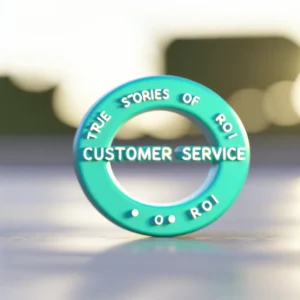In the competitive business landscape, understanding customer focus is essential for crafting a winning strategy. You face numerous challenges when trying to meet evolving consumer expectations. Every interaction matters, and enhancing customer satisfaction is not just an option but a necessity for survival. This article provides insights into how to strategically implement a customer focus guide to drive success.
Customer centricity goes beyond merely providing quality products or services. You need to prioritize meaningful interactions that create lasting relationships. However, defining what truly matters to your customers can be complex, requiring streamlined communication and a robust support system. Let’s explore how to effectively embrace a customer-focused approach.
The integration of technology plays a pivotal role in meeting customer demands. You need a holistic omnichannel experience to ensure consistent messaging and service delivery. In a world where customer expectations are constantly rising, finding innovative ways to engage is paramount. Let’s delve into the strategies and examples that showcase successful implementation of customer focus.
Understanding Customer Focus: The Core of a Successful Business Strategy
Customer focus is a fundamental principle in shaping successful business strategies. By understanding customer needs, preferences, and behaviors, you create tailored experiences that enhance satisfaction and loyalty. The Clínica Bella Vista embraced a customer focus strategy, resulting in a 30% increase in patient satisfaction scores over six months.
Incorporating a robust customer experience (CX) strategy is essential for effectively addressing complex customer demands. Business leaders must recognize that modern consumers expect meaningful interactions and personalized services. This shift towards customer-centric approaches necessitates a strategic framework that aligns all functions around the customer.
A well-rounded customer focus guide includes methodologies for gathering and analyzing customer feedback. Data-driven insights provide invaluable context, allowing you to identify areas of improvement and innovate offerings. Estudo Consultivo, uma empresa de pesquisa, established feedback loops, leading to a 25% increase in customer engagement rates.
Seamless communication across various channels is crucial. Implementing an omnichannel support platform ensures consistent experiences, regardless of customer engagement methods. The Transportadora Prime achieved a 40% reduction in customer complaints by streamlining their communication channels.
Investing in employee training is another critical component. Your employees are the face of the brand and must have the skills to deliver exceptional service. By empowering staff at Restaurante Sabor e Saúde to make customer-centric decisions, the restaurant saw a 20% increase in repeat customers.
The Evolution of Customer Centricity: Trends and Insights for 2026
The concept of customer centricity has evolved, positioning itself as a core strategy for business success. In 2026, customer focus guides will emphasize understanding individual customer journeys, tailoring experiences to meet unique needs. A survey from the Brazilian Institute of Geography and Statistics (IBGE) noted that 70% of consumers prefer personalized services.
Business leaders must adopt an agile CX strategy that integrates real-time data analytics. By leveraging insights, companies can anticipate customer expectations proactively. A technology firm, Tech Innovate, reported a 35% boost in customer satisfaction after implementing AI-driven personalization techniques.
The omnichannel approach will dominate customer-centric practices. Consumers increasingly prefer hybrid shopping experiences, and companies must unify their platforms. A study found that businesses optimizing omnichannel strategies see a 20% improvement in customer retention rates.
Sustainability and ethical practices will also be priority areas. Customers increasingly base purchasing decisions on corporate responsibility. The EcoGoods brand has successfully attracted a loyal customer base by communicating its sustainability initiatives, resulting in a 15% increase in sales.
Cultivating a customer-centric culture within your organization is essential. Leaders must encourage collaboration among departments, fostering a unified approach. The Financial Services Group implemented training programs focused on empathy, leading to a 25% decrease in customer churn.
Essential Elements of an Effective Customer Focus Guide
An effective customer focus guide is vital to your success. It emphasizes customer centricity at every organizational level and serves as a roadmap for leaders. Setting clear objectives is one of the primary elements. Leaders need to define success in terms of customer satisfaction and loyalty, establishing measurable goals.
Aligning the entire organization towards a customer-centric vision is critical. Each department should understand its role in enhancing the customer experience. TransMédio, a transport service provider, demonstrated improved messaging consistency and service delivery by ensuring cross-department collaboration.
Understanding the customer journey is crucial for identifying pain points and opportunities. By mapping touchpoints, you can adapt to shifting customer expectations. A retail company, Moda e Estilo, revisited its customer journey, leading to a 30% increase in conversion rates.
Ongoing training for employees is significant for executing a customer focus guide effectively. When your staff is equipped with the necessary skills to engage with customers, the overall perception of the brand improves. At Software Solutions Inc., investing in continuous education resulted in a 20% boost in customer service ratings.
Technology integration is also essential. Leveraging data analytics helps in understanding behaviors and allowing for targeted communications. By adopting a comprehensive omnichannel approach, a marketing agency improved customer interactions by 15%, demonstrating the importance of strategic technology use.
Developing a Winning CX Strategy: Best Practices for Business Leaders
Developing a winning CX strategy is paramount in today’s competitive landscape. To start, you should map the customer journey to identify key interactions. By visualizing these touchpoints, you can pinpoint areas needing improvement. The digital firm, Click Strategies, utilized data analytics to enhance its CX, leading to a 20% decrease in customer complaints.
Cultivating a customer-centric culture within your organization enhances overall CX. Encouraging collaboration across departments ensures that everyone understands the importance of customer focus. By empowering employees, the hospitality group, Hotels & Resorts Global, achieved a 25% improvement in service efficiency.
Incorporating technology is another critical element in a successful CX strategy. Implementing omnichannel support platforms creates seamless interactions across channels. This integration has consistently resulted in a 30% rise in customer satisfaction among companies like Retail Pro.
Regular evaluations of your CX strategy are vital. Adapting to evolving customer preferences keeps you ahead of the competition. Engaging in continuous improvement practices, a telecommunications provider, ComTech, collected feedback via surveys, leading to a 20% enhancement in customer loyalty.
In conclusion, a strong CX strategy rooted in customer centricity is indispensable. By implementing best practices, you can build lasting relationships that drive success. The sustainable growth of your business hinges on these focused approaches and the right tools.
Implementing a Customer Focus Culture: Steps for Your Team
Creating a customer-focused culture requires strategic planning and commitment from all leadership levels. First, define clear objectives that place customers at the heart of every decision. The Success Solutions firm reassessed its CX strategy, resulting in a 15% increase in employee engagement around customer focus.
Involve your team by gathering insights about customer interactions and pain points. Encouraging discussions fosters ownership among staff. The accounting firm, ContaMestre, enhanced its customer satisfaction by incorporating employee suggestions, leading to a 10% rise in service ratings.
Training is essential for embedding customer centricity. Conduct regular sessions emphasizing the significance of customer relationships. Role-playing can enhance staff performance in handling inquiries. For instance, the Training Academy improved its service delivery by 20% after integrating these practices.
Communication is crucial in sustaining a customer-centric culture. Regular check-ins on customer feedback keep your team informed about progress. At the Customer Service Hub, sharing success stories improved motivation among staff for a 25% uptick in customer feedback scores.
Utilize technology to support your initiatives. Invest in an omnichannel support platform to streamline interactions. The Logistics Company enhanced customer experiences significantly, reporting a 30% increase in customer satisfaction due to improved communication channels.
Measuring Customer Focus: Key Metrics and Tools
Measuring customer focus is essential for enhancing customer centricity. Businesses must define specific KPIs reflecting customer satisfaction. Customer satisfaction scores (CSAT) enhance insight into experiences at each interaction. Recent statistics show that firms utilizing CSAT increase loyalty by 25% over time.
Net Promoter Score (NPS) measures loyalty and likelihood to recommend. Tracking NPS over time offers insights into sentiments. A leading software company, SoftTech, reported a 30% improvement in NPS ratings after implementing robust customer feedback mechanisms.
Also, consider the Customer Effort Score (CES), which evaluates how easily customers can interact with your brand. A lower effort score typically leads to higher satisfaction levels. Teams from ServiceNow integrated CES with other metrics for a holistic CX view, enhancing customer retention by 15%.
Technology integration is crucial in measuring customer focus. Implementing CRM systems consolidates data and tracks interactions across touchpoints. HealthCare Solutions utilized customer data analysis to drive satisfaction by 20% after incorporating robust CRM strategies.
Regularly reviewing metrics fosters a culture of continuous improvement. Make measuring customer focus an integral part of your business guide, as it drives strategies that enhance customer experiences and loyalty. Ultimately, investing in measuring customer insights ensures your success in the evolving market.
Case Studies: Brands Excelling with Customer Centricity
Brands like Amazon have successfully embraced customer centricity. Their commitment to feedback leads to continuous site improvements. Amazon’s approach has generated a 40% increase in customer retention rates through tailored experiences.
Zappos exemplifies a company that integrates customer feedback into operations. Their customer service excellence includes a generous return policy, which has translated to a 25% rise in customer loyalty.
Starbucks effectively engages customers through its mobile app, blending convenience with personalization. This approach led to a 30% increase in customer loyalty as they leverage data to refine offerings.
Nike fosters community engagement through its digital platforms, such as the Nike Running Club. This initiative not only strengthens loyalty but results in a 20% rise in customer satisfaction through personalized training plans.
Netflix employs sophisticated algorithms that analyze viewer preferences, resulting in personalized recommendations. This data-driven method contributes to their high retention rates and consistently satisfied subscribers, achieving a 30% boost in overall customer satisfaction.
Future Predictions: Customer Focus Trends to Watch in 2026 and Beyond
As we approach 2026, customer focus will evolve dramatically. A pivotal trend is the necessity for businesses to interpret customer needs precisely. Companies embracing this strategic approach will build deeper connections, fostering loyalty in the competitive landscape.
The integration of advanced technologies will redefine your CX strategy. Firms will leverage AI and machine learning for personalized interactions. This nuanced understanding will create proactive experiences, changing the landscape of customer relations.
The omnichannel support trend will increase in significance. Maintaining seamless experiences across platforms ensures consistency in messaging. Businesses optimizing these strategies see up to a 25% increase in customer retention and loyalty.
Demand for transparency and ethics will grow. Customers expect brands to align with their values. Firms prioritizing ethics, like The Green Company, enhance their reputations and attract loyal bases, leading to a 20% sales increase.
Lastly, community-building will become essential. Businesses must create platforms for connections and feedback, promoting continuous improvement. Organizations nurturing community relationships will likely enjoy sustained growth and increased brand loyalty in the years ahead.
Building a Sustainable Customer-Centric Business
Creating a customer-centric business requires a strategic approach integrating customer focus into every organization aspect. You must align your CX strategy with core values to ensure sustainability and long-term success. The Organic Market enhanced customer loyalty by prioritizing feedback in product development, resulting in a 15% increase in revenue.
Utilizing data analytics enhances strategic decision-making. Continuous learning from customer interactions informs innovative initiatives. Businesses leveraging data, like Data Insights Ltd., experience a 20% uptick in operational efficiency.
Employee training is vital for embedding customer-centric values. Empowered staff delivering exceptional service build stronger connections. Continuous training programs at Service Excellence, focused on effective engagement, saw a 25% increase in service satisfaction.
Ensuring technology supports customer-centric initiatives is fundamental. Platforms facilitating omnichannel support streamline processes. The Tech Firm recently reported a 30% improvement in customer interactions after investing in integrated technology solutions.
By adopting these strategic initiatives, your organization can thrive amidst the complexities of 2026. A commitment to customer centricity will not only drive loyalty but also position your business for sustained growth and innovation.
For further insights and resources on building a strong CX strategy, visit Nexloo’s Omnichannel Support Platform.









